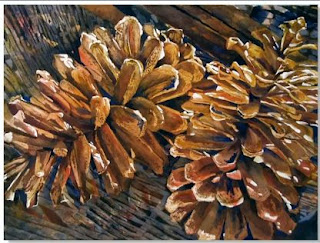 |
| Watercolor, Paul Talbot-Greaves |
Wednesday, October 26, 2011
Watercolour demonstration by Paul Talbot-Greaves
Labels:
Landscape,
Paul Talbot-Greaves,
step-by-step,
Watercolor
Monday, October 10, 2011
Poured Watercolor with Stephen Blackburn
 |
| Watercolor by Stephen Blackburn |
Labels:
Articles by Artists,
Florals,
Poured Watercolor,
step-by-step,
Stephen Blackburn,
Still Life
Sunday, October 9, 2011
How to Add Contrast to a Painting With a Dark Glaze
 |
| Pinecones by Linda Baker |
Labels:
Fix Tips,
glazing,
Linda Baker,
video-demo,
Watercolor
Friday, October 7, 2011
Horse Portrait in Watercolor
Step by step watercolor demo by Twyla (Ironhorse) of a Quarterhorse named "Star". Many progress photos shown.
Labels:
Animals-Wildlife,
equine,
horses,
step-by-step,
Watercolor
Wednesday, October 5, 2011
Manhattan Watercolor Demonstration
 |
| Mixed Emotions, James Toogood, watercolor |
Labels:
Buildings-Structures,
James Toogood,
Watercolor
Tuesday, October 4, 2011
How to Paint Cat's Eyes
Labels:
Animals-Wildlife,
cat,
step-by-step,
Watercolor
Saturday, October 1, 2011
Watercolor Batik
 |
| Tuscan Window by Kathie George |
With batik, wax is used as a resist—and if you’ve ever used masking fluid on watercolor paper, you understand how a resist works. The wax blocks the areas that
aren’t intended to receive paint. The materials Kathie uses are rice paper, watercolor and melted paraffin wax. This process isn’t an exact science, so be prepared for mistakes such as unintentional drips of wax and oozing color. Believe it or not, these accidents actually add to the look of the piece. View batik tutorial here.
aren’t intended to receive paint. The materials Kathie uses are rice paper, watercolor and melted paraffin wax. This process isn’t an exact science, so be prepared for mistakes such as unintentional drips of wax and oozing color. Believe it or not, these accidents actually add to the look of the piece. View batik tutorial here.
Kathie George and this painting were featured in Splash 11 - New Directions: The Best of Watercolor which showcases the finest watercolor paintings being created today.
Labels:
Buildings-Structures,
Kathie George,
step-by-step,
Watercolor
Subscribe to:
Posts (Atom)


